The Killer of Little Shepherds Bonus Material
Q&A
Q: The Killer of Little Shepherds: A True Crime Story and the Birth of Forensic Science is the true story account of a serial killer, Joseph Vacher, loose in the French countryside during the 19th century just as the field of forensic science was growing; it would lead to his apprehension. How did you come across this moment in history and what drew you to investigating it in this book?
A: I’ve always been interested in stories in which science plays a role in human drama, especially mysteries. I started on several projects, one of which involved following a murder trial that involved DNA, but none of those ideas panned out. Then one day, while poring through some medical journals, I came upon a thesis about the case of the serial killer and the scientist—Joseph Vacher and Dr. Alexandre Lacassagne. I became fascinated with the pioneers of forensic science, or CSI as people call it today. I also was drawn to the period. The turn-of-the-century was a lot like our own time: it was a period of tremendous scientific advancement, yet a time of great anxiety as well. There was a troubling gap between the haves and have-nots. A global terrorist movement, anarchism was rising. It was also an amazing turning point in human history, when the questions of good and evil moved from the realm of the clergy to that of the scientists.
What captivated me most, however, were the characters. Vacher was not simply evil. He was a man consumed by pain and self-pity, capable of soaring passions, but also unspeakable crimes. On the other hand, Dr. Lacassagne personified all that was admirable about his era—educated, humane, a renaissance man, not only in the field of criminal analysis, but in other areas of social progress, including public health and prison reform. He genuinely believed that science could solve the problems of society. He was remarkably unprejudiced for his times, and in many ways was ahead of his era. I wish I could have met him.
Gallery
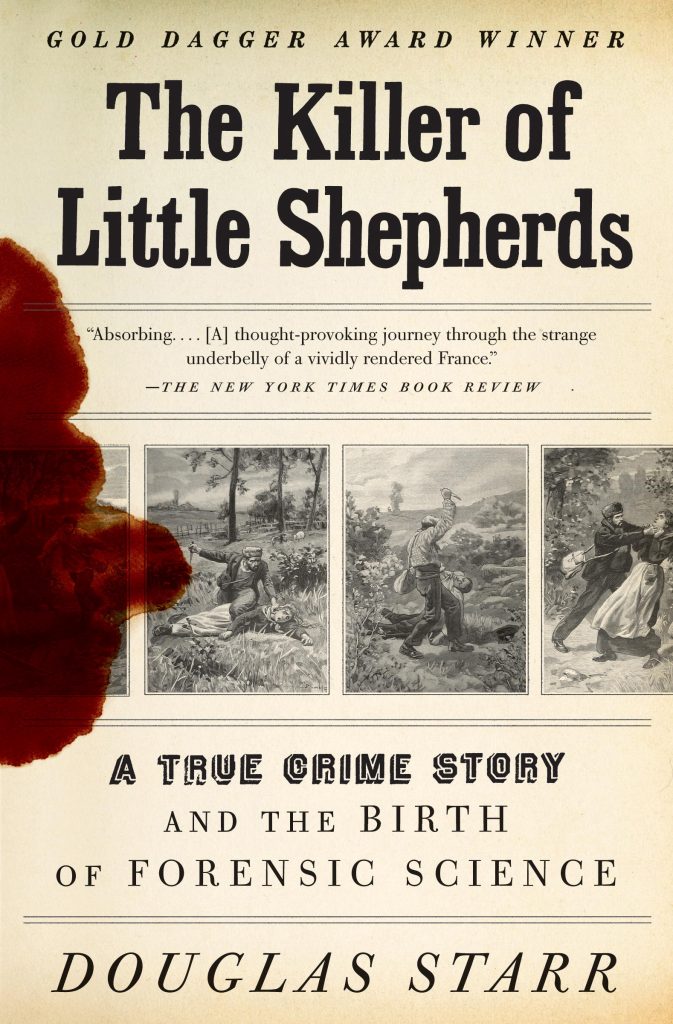
Q&A
Q: The Killer of Little Shepherds: A True Crime Story and the Birth of Forensic Science is the true story account of a serial killer, Joseph Vacher, loose in the French countryside during the 19th century just as the field of forensic science was growing; it would lead to his apprehension. How did you come across this moment in history and what drew you to investigating it in this book?A: I’ve always been interested in stories in which science plays a role in human drama, especially mysteries. I started on several projects, one of which involved following a murder trial that involved DNA, but none of those ideas panned out. Then one day, while poring through some medical journals, I came upon a thesis about the case of the serial killer and the scientist-Joseph Vacher and Dr. Alexandre Lacassagne. I became fascinated with the pioneers of forensic science, or CSI as people call it today. I also was drawn to the period. The turn-of-the-century was a lot like our own time: it was a period of tremendous scientific advancement, yet a time of great anxiety as well. There was a troubling gap between the haves and have-nots. A global terrorist movement, anarchism was rising. It was also an amazing turning point in human history, when the questions of good and evil moved from the realm of the clergy to that of the scientists.
What captivated me most, however, were the characters. Vacher was not simply evil. He was a man consumed by pain and self-pity, capable of soaring passions, but also unspeakable crimes. On the other hand, Dr. Lacassagne personified all that was admirable about his era-educated, humane, a renaissance man, not only in the field of criminal analysis, but in other areas of social progress, including public health and prison reform. He genuinely believed that science could solve the problems of society. He was remarkably unprejudiced for his times, and in many ways was ahead of his era. I wish I could have met him.
Gallery
 Tabloid portrayal of the murder of 13-year-old Louise Marcel. A favorite topic in the “penny press” was the dramatic illustration of crime.
Tabloid portrayal of the murder of 13-year-old Louise Marcel. A favorite topic in the “penny press” was the dramatic illustration of crime.
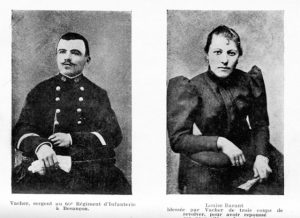 Vacher and Louise Barant, who he became obsessed with and tried to murder. The crime sent him to a series of insane asylums, although he later was released.
Vacher and Louise Barant, who he became obsessed with and tried to murder. The crime sent him to a series of insane asylums, although he later was released.
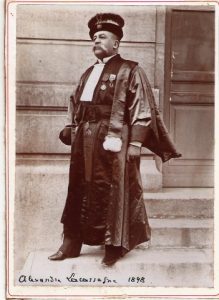 Alexandre Lacassagne in 1898, the year of Vacher’s trial, in full academic regalia. When testifying he wore a somber business suit.
Alexandre Lacassagne in 1898, the year of Vacher’s trial, in full academic regalia. When testifying he wore a somber business suit.
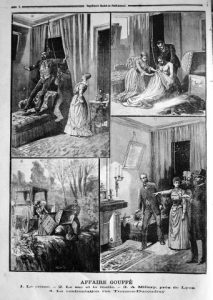 Tabloid depiction of the Gouffé affair, the murder investigation that made Dr. Lacassagne internationally famous.
Tabloid depiction of the Gouffé affair, the murder investigation that made Dr. Lacassagne internationally famous.
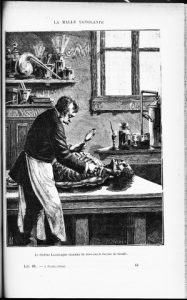 Lacassagne’s autopsy of Gouffé, who was murdered in Paris and whose body was dumped south of Lyon. Lacassagne’s identification of the decomposed body cracked the case.
Lacassagne’s autopsy of Gouffé, who was murdered in Paris and whose body was dumped south of Lyon. Lacassagne’s identification of the decomposed body cracked the case.
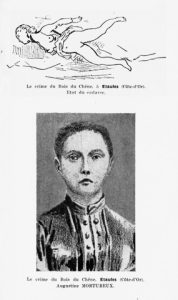 Murder victim Augustine Mortureux, Vacher’s third documented victim, and the crime scene diagram. Vacher confessed to 11 killings, but was thought to have committed more than 25.
Murder victim Augustine Mortureux, Vacher’s third documented victim, and the crime scene diagram. Vacher confessed to 11 killings, but was thought to have committed more than 25.
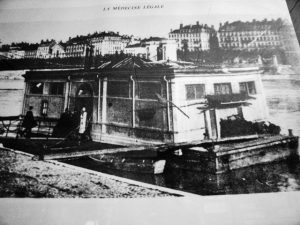 The floating morgue of Lyon, a dank, leaky, unsanitary facility, where Lacassagne worked for nearly 30 years. Storms would sometimes wash bodies overboard.
The floating morgue of Lyon, a dank, leaky, unsanitary facility, where Lacassagne worked for nearly 30 years. Storms would sometimes wash bodies overboard.
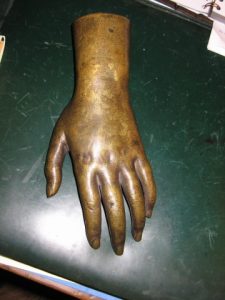 Lacassagne, an ardent book and art collector, also collected artifacts from crime scenes. This paperweight is bronze casting of female criminal’s hand. A duplicate serves as a door knocker at his summer home.
Lacassagne, an ardent book and art collector, also collected artifacts from crime scenes. This paperweight is bronze casting of female criminal’s hand. A duplicate serves as a door knocker at his summer home.
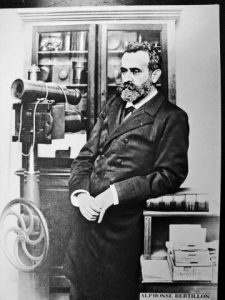 Alphonse Bertillon developed a system of identification based on the measurements of certain body parts. It predated fingerprinting and presaged the modern use of biometrics.
Alphonse Bertillon developed a system of identification based on the measurements of certain body parts. It predated fingerprinting and presaged the modern use of biometrics.
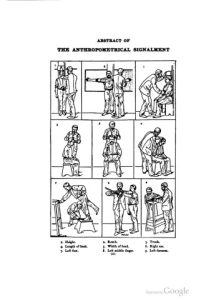 Bertillon’s system, translated in an American police text. The combination of eleven critical measurements narrowed the odds of a mis-identification to less than one in 4 million.
Bertillon’s system, translated in an American police text. The combination of eleven critical measurements narrowed the odds of a mis-identification to less than one in 4 million.
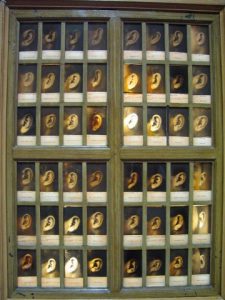 Ear identification chart. Bertillon believed that ears were unique to each individual, and produced charts indicating ear-shapes.
Ear identification chart. Bertillon believed that ears were unique to each individual, and produced charts indicating ear-shapes.
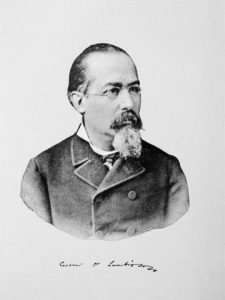 Cesare Lombroso developed the “born criminal” theory, which stated that the tendency to commit crimes is genetic, and was revealed in certain telltale body traits.
Cesare Lombroso developed the “born criminal” theory, which stated that the tendency to commit crimes is genetic, and was revealed in certain telltale body traits.
 Diagram from Lombroso’s book showing features of the born criminal. He referred to such features, such as a low forehead, large jaw and jug ears, as “stigmata.”
Diagram from Lombroso’s book showing features of the born criminal. He referred to such features, such as a low forehead, large jaw and jug ears, as “stigmata.”
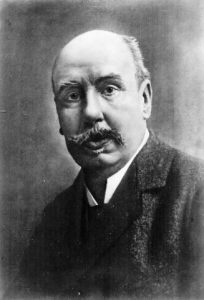 Austrian criminologist Hans Gross introduced and advocated many modern techniques, including interviews based on persuasion rather than torture.
Austrian criminologist Hans Gross introduced and advocated many modern techniques, including interviews based on persuasion rather than torture.
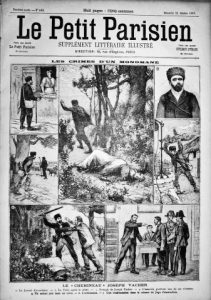 Tabloid coverage of Vacher’s killing spree: “Crimes of a Monomaniac.”
Tabloid coverage of Vacher’s killing spree: “Crimes of a Monomaniac.”
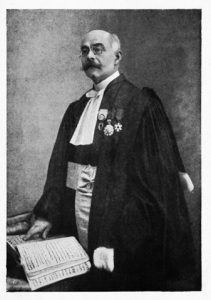 Investigative magistrate Émile Fourquet first saw a pattern in Vacher’s killing spree and played a key role in bringing him to justice.
Investigative magistrate Émile Fourquet first saw a pattern in Vacher’s killing spree and played a key role in bringing him to justice.
 Vacher’s confession: “To France: So much the worse for you if you think I am responsible.” It begins with his trademark epigram: “DIEU-DROITS-DEVOIRS” (GOD-RIGHTS-OBLIGATIONS).
Vacher’s confession: “To France: So much the worse for you if you think I am responsible.” It begins with his trademark epigram: “DIEU-DROITS-DEVOIRS” (GOD-RIGHTS-OBLIGATIONS).
 Vacher’s portrait at Belley prison. He insisted on posing with a white rabbit hat (symbol of purity) and keys to unlock the gates of heaven. He borrowed the keys from a prison guard.
Vacher’s portrait at Belley prison. He insisted on posing with a white rabbit hat (symbol of purity) and keys to unlock the gates of heaven. He borrowed the keys from a prison guard.
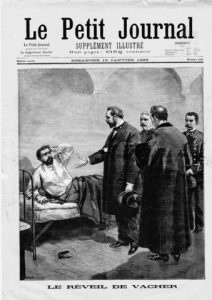 “THE WAKING OF VACHER.” Tabloid depiction of officials preparing Vacher for the guillotine.
“THE WAKING OF VACHER.” Tabloid depiction of officials preparing Vacher for the guillotine.
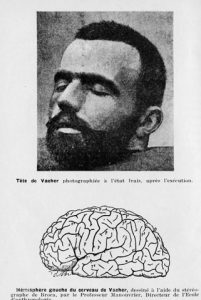 Vacher’s severed head and the post-mortem diagram of his brain. After his execution, Vacher’s brain, divided up and dissected by several anatomists, became the focus of a heated debate over whether it showed signs of insanity.
Vacher’s severed head and the post-mortem diagram of his brain. After his execution, Vacher’s brain, divided up and dissected by several anatomists, became the focus of a heated debate over whether it showed signs of insanity.

Q&A
Q: The Killer of Little Shepherds: A True Crime Story and the Birth of Forensic Science is the true story account of a serial killer, Joseph Vacher, loose in the French countryside during the 19th century just as the field of forensic science was growing; it would lead to his apprehension. How did you come across this moment in history and what drew you to investigating it in this book?A: I’ve always been interested in stories in which science plays a role in human drama, especially mysteries. I started on several projects, one of which involved following a murder trial that involved DNA, but none of those ideas panned out. Then one day, while poring through some medical journals, I came upon a thesis about the case of the serial killer and the scientist-Joseph Vacher and Dr. Alexandre Lacassagne. I became fascinated with the pioneers of forensic science, or CSI as people call it today. I also was drawn to the period. The turn-of-the-century was a lot like our own time: it was a period of tremendous scientific advancement, yet a time of great anxiety as well. There was a troubling gap between the haves and have-nots. A global terrorist movement, anarchism was rising. It was also an amazing turning point in human history, when the questions of good and evil moved from the realm of the clergy to that of the scientists.
What captivated me most, however, were the characters. Vacher was not simply evil. He was a man consumed by pain and self-pity, capable of soaring passions, but also unspeakable crimes. On the other hand, Dr. Lacassagne personified all that was admirable about his era-educated, humane, a renaissance man, not only in the field of criminal analysis, but in other areas of social progress, including public health and prison reform. He genuinely believed that science could solve the problems of society. He was remarkably unprejudiced for his times, and in many ways was ahead of his era. I wish I could have met him.
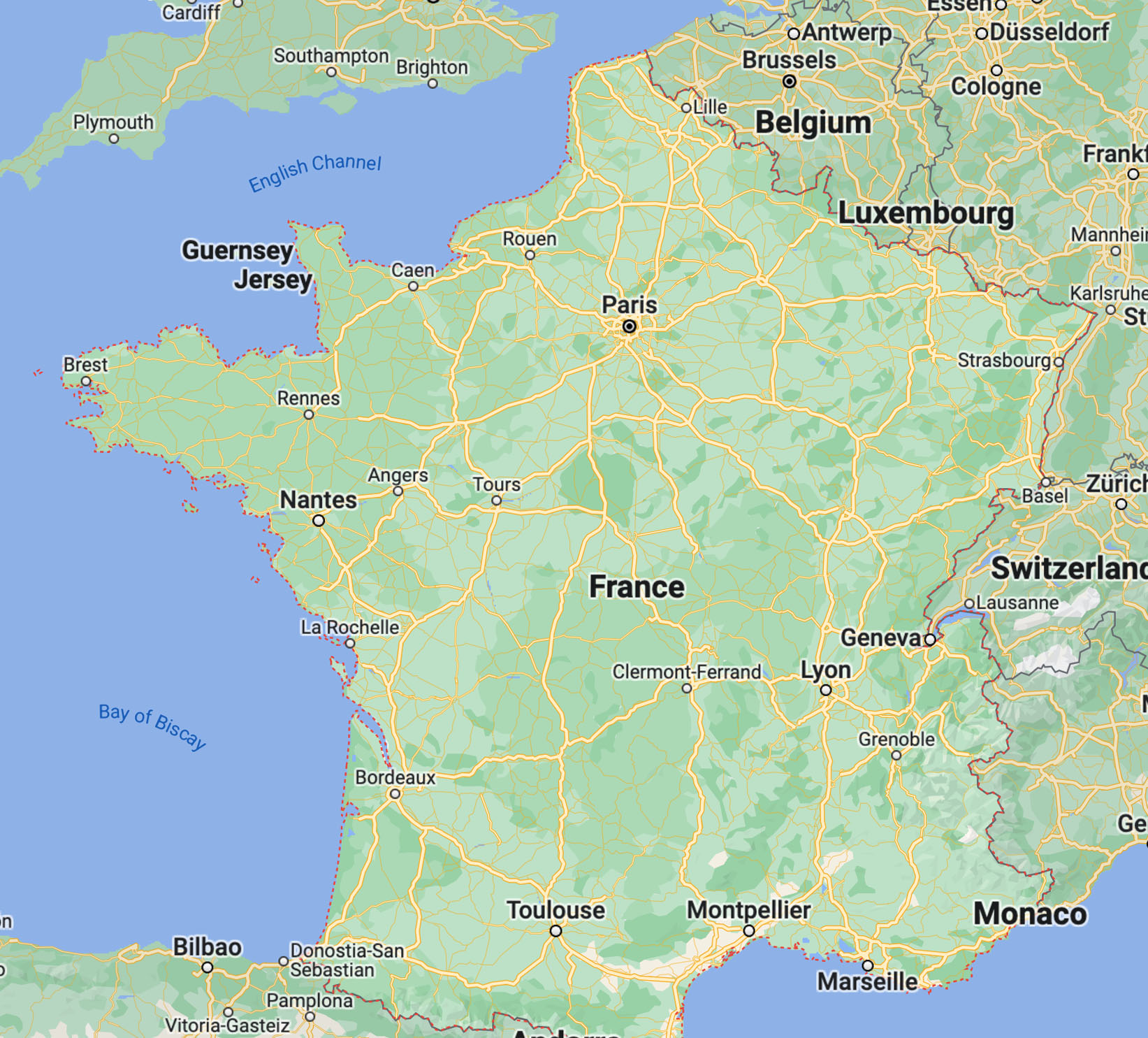 Paris
Paris
January 1899-Vacher’s brain sent to Paris where it is divided up and studied by neurologists.
LyonDecember 31, 1897 – Vacher transferred to St. Paul prison for several months of observation and study by Dr. Lacassagne and colleagues.
Tassin-la-Demi-LuneLate May, 1896 – Vacher kills Claudius Beaupied, 14, and throws the body down a well. The body is not discovered until October, 1897.
CourzieuJune 18, 1897 – Vacher kills Pierre Laurent, 13.
VidaubanNovember 20, 1894 – Vacher kills Louise Marcel, a 13-year-old shepherdess.
Gallery
 Tabloid portrayal of the murder of 13-year-old Louise Marcel. A favorite topic in the “penny press” was the dramatic illustration of crime.
Tabloid portrayal of the murder of 13-year-old Louise Marcel. A favorite topic in the “penny press” was the dramatic illustration of crime.
 Vacher and Louise Barant, who he became obsessed with and tried to murder. The crime sent him to a series of insane asylums, although he later was released.
Vacher and Louise Barant, who he became obsessed with and tried to murder. The crime sent him to a series of insane asylums, although he later was released.
 Alexandre Lacassagne in 1898, the year of Vacher’s trial, in full academic regalia. When testifying he wore a somber business suit.
Alexandre Lacassagne in 1898, the year of Vacher’s trial, in full academic regalia. When testifying he wore a somber business suit.
 Tabloid depiction of the Gouffé affair, the murder investigation that made Dr. Lacassagne internationally famous.
Tabloid depiction of the Gouffé affair, the murder investigation that made Dr. Lacassagne internationally famous.
 Lacassagne’s autopsy of Gouffé, who was murdered in Paris and whose body was dumped south of Lyon. Lacassagne’s identification of the decomposed body cracked the case.
Lacassagne’s autopsy of Gouffé, who was murdered in Paris and whose body was dumped south of Lyon. Lacassagne’s identification of the decomposed body cracked the case.
 Murder victim Augustine Mortureux, Vacher’s third documented victim, and the crime scene diagram. Vacher confessed to 11 killings, but was thought to have committed more than 25.
Murder victim Augustine Mortureux, Vacher’s third documented victim, and the crime scene diagram. Vacher confessed to 11 killings, but was thought to have committed more than 25.
 The floating morgue of Lyon, a dank, leaky, unsanitary facility, where Lacassagne worked for nearly 30 years. Storms would sometimes wash bodies overboard.
The floating morgue of Lyon, a dank, leaky, unsanitary facility, where Lacassagne worked for nearly 30 years. Storms would sometimes wash bodies overboard.
 Lacassagne, an ardent book and art collector, also collected artifacts from crime scenes. This paperweight is bronze casting of female criminal’s hand. A duplicate serves as a door knocker at his summer home.
Lacassagne, an ardent book and art collector, also collected artifacts from crime scenes. This paperweight is bronze casting of female criminal’s hand. A duplicate serves as a door knocker at his summer home.
 Alphonse Bertillon developed a system of identification based on the measurements of certain body parts. It predated fingerprinting and presaged the modern use of biometrics.
Alphonse Bertillon developed a system of identification based on the measurements of certain body parts. It predated fingerprinting and presaged the modern use of biometrics.
 Bertillon’s system, translated in an American police text. The combination of eleven critical measurements narrowed the odds of a mis-identification to less than one in 4 million.
Bertillon’s system, translated in an American police text. The combination of eleven critical measurements narrowed the odds of a mis-identification to less than one in 4 million.
 Ear identification chart. Bertillon believed that ears were unique to each individual, and produced charts indicating ear-shapes.
Ear identification chart. Bertillon believed that ears were unique to each individual, and produced charts indicating ear-shapes.
 Cesare Lombroso developed the “born criminal” theory, which stated that the tendency to commit crimes is genetic, and was revealed in certain telltale body traits.
Cesare Lombroso developed the “born criminal” theory, which stated that the tendency to commit crimes is genetic, and was revealed in certain telltale body traits.
 Diagram from Lombroso’s book showing features of the born criminal. He referred to such features, such as a low forehead, large jaw and jug ears, as “stigmata.”
Diagram from Lombroso’s book showing features of the born criminal. He referred to such features, such as a low forehead, large jaw and jug ears, as “stigmata.”
 Austrian criminologist Hans Gross introduced and advocated many modern techniques, including interviews based on persuasion rather than torture.
Austrian criminologist Hans Gross introduced and advocated many modern techniques, including interviews based on persuasion rather than torture.
 Tabloid coverage of Vacher’s killing spree: “Crimes of a Monomaniac.”
Tabloid coverage of Vacher’s killing spree: “Crimes of a Monomaniac.”
 Investigative magistrate Émile Fourquet first saw a pattern in Vacher’s killing spree and played a key role in bringing him to justice.
Investigative magistrate Émile Fourquet first saw a pattern in Vacher’s killing spree and played a key role in bringing him to justice.
 Vacher’s confession: “To France: So much the worse for you if you think I am responsible.” It begins with his trademark epigram: “DIEU-DROITS-DEVOIRS” (GOD-RIGHTS-OBLIGATIONS).
Vacher’s confession: “To France: So much the worse for you if you think I am responsible.” It begins with his trademark epigram: “DIEU-DROITS-DEVOIRS” (GOD-RIGHTS-OBLIGATIONS).
 Vacher’s portrait at Belley prison. He insisted on posing with a white rabbit hat (symbol of purity) and keys to unlock the gates of heaven. He borrowed the keys from a prison guard.
Vacher’s portrait at Belley prison. He insisted on posing with a white rabbit hat (symbol of purity) and keys to unlock the gates of heaven. He borrowed the keys from a prison guard.
 “THE WAKING OF VACHER.” Tabloid depiction of officials preparing Vacher for the guillotine.
“THE WAKING OF VACHER.” Tabloid depiction of officials preparing Vacher for the guillotine.
 Vacher’s severed head and the post-mortem diagram of his brain. After his execution, Vacher’s brain, divided up and dissected by several anatomists, became the focus of a heated debate over whether it showed signs of insanity.
Vacher’s severed head and the post-mortem diagram of his brain. After his execution, Vacher’s brain, divided up and dissected by several anatomists, became the focus of a heated debate over whether it showed signs of insanity.

Q&A
Q: The Killer of Little Shepherds: A True Crime Story and the Birth of Forensic Science is the true story account of a serial killer, Joseph Vacher, loose in the French countryside during the 19th century just as the field of forensic science was growing; it would lead to his apprehension. How did you come across this moment in history and what drew you to investigating it in this book?A: I’ve always been interested in stories in which science plays a role in human drama, especially mysteries. I started on several projects, one of which involved following a murder trial that involved DNA, but none of those ideas panned out. Then one day, while poring through some medical journals, I came upon a thesis about the case of the serial killer and the scientist-Joseph Vacher and Dr. Alexandre Lacassagne. I became fascinated with the pioneers of forensic science, or CSI as people call it today. I also was drawn to the period. The turn-of-the-century was a lot like our own time: it was a period of tremendous scientific advancement, yet a time of great anxiety as well. There was a troubling gap between the haves and have-nots. A global terrorist movement, anarchism was rising. It was also an amazing turning point in human history, when the questions of good and evil moved from the realm of the clergy to that of the scientists.
What captivated me most, however, were the characters. Vacher was not simply evil. He was a man consumed by pain and self-pity, capable of soaring passions, but also unspeakable crimes. On the other hand, Dr. Lacassagne personified all that was admirable about his era-educated, humane, a renaissance man, not only in the field of criminal analysis, but in other areas of social progress, including public health and prison reform. He genuinely believed that science could solve the problems of society. He was remarkably unprejudiced for his times, and in many ways was ahead of his era. I wish I could have met him.
Map
Gallery
 Tabloid portrayal of the murder of 13-year-old Louise Marcel. A favorite topic in the “penny press” was the dramatic illustration of crime.
Tabloid portrayal of the murder of 13-year-old Louise Marcel. A favorite topic in the “penny press” was the dramatic illustration of crime.
 Vacher and Louise Barant, who he became obsessed with and tried to murder. The crime sent him to a series of insane asylums, although he later was released.
Vacher and Louise Barant, who he became obsessed with and tried to murder. The crime sent him to a series of insane asylums, although he later was released.
 Alexandre Lacassagne in 1898, the year of Vacher’s trial, in full academic regalia. When testifying he wore a somber business suit.
Alexandre Lacassagne in 1898, the year of Vacher’s trial, in full academic regalia. When testifying he wore a somber business suit.
 Tabloid depiction of the Gouffé affair, the murder investigation that made Dr. Lacassagne internationally famous.
Tabloid depiction of the Gouffé affair, the murder investigation that made Dr. Lacassagne internationally famous.
 Lacassagne’s autopsy of Gouffé, who was murdered in Paris and whose body was dumped south of Lyon. Lacassagne’s identification of the decomposed body cracked the case.
Lacassagne’s autopsy of Gouffé, who was murdered in Paris and whose body was dumped south of Lyon. Lacassagne’s identification of the decomposed body cracked the case.
 Murder victim Augustine Mortureux, Vacher’s third documented victim, and the crime scene diagram. Vacher confessed to 11 killings, but was thought to have committed more than 25.
Murder victim Augustine Mortureux, Vacher’s third documented victim, and the crime scene diagram. Vacher confessed to 11 killings, but was thought to have committed more than 25.
 The floating morgue of Lyon, a dank, leaky, unsanitary facility, where Lacassagne worked for nearly 30 years. Storms would sometimes wash bodies overboard.
The floating morgue of Lyon, a dank, leaky, unsanitary facility, where Lacassagne worked for nearly 30 years. Storms would sometimes wash bodies overboard.
 Lacassagne, an ardent book and art collector, also collected artifacts from crime scenes. This paperweight is bronze casting of female criminal’s hand. A duplicate serves as a door knocker at his summer home.
Lacassagne, an ardent book and art collector, also collected artifacts from crime scenes. This paperweight is bronze casting of female criminal’s hand. A duplicate serves as a door knocker at his summer home.
 Alphonse Bertillon developed a system of identification based on the measurements of certain body parts. It predated fingerprinting and presaged the modern use of biometrics.
Alphonse Bertillon developed a system of identification based on the measurements of certain body parts. It predated fingerprinting and presaged the modern use of biometrics.
 Bertillon’s system, translated in an American police text. The combination of eleven critical measurements narrowed the odds of a mis-identification to less than one in 4 million.
Bertillon’s system, translated in an American police text. The combination of eleven critical measurements narrowed the odds of a mis-identification to less than one in 4 million.
 Ear identification chart. Bertillon believed that ears were unique to each individual, and produced charts indicating ear-shapes.
Ear identification chart. Bertillon believed that ears were unique to each individual, and produced charts indicating ear-shapes.
 Cesare Lombroso developed the “born criminal” theory, which stated that the tendency to commit crimes is genetic, and was revealed in certain telltale body traits.
Cesare Lombroso developed the “born criminal” theory, which stated that the tendency to commit crimes is genetic, and was revealed in certain telltale body traits.
 Diagram from Lombroso’s book showing features of the born criminal. He referred to such features, such as a low forehead, large jaw and jug ears, as “stigmata.”
Diagram from Lombroso’s book showing features of the born criminal. He referred to such features, such as a low forehead, large jaw and jug ears, as “stigmata.”
 Austrian criminologist Hans Gross introduced and advocated many modern techniques, including interviews based on persuasion rather than torture.
Austrian criminologist Hans Gross introduced and advocated many modern techniques, including interviews based on persuasion rather than torture.
 Tabloid coverage of Vacher’s killing spree: “Crimes of a Monomaniac.”
Tabloid coverage of Vacher’s killing spree: “Crimes of a Monomaniac.”
 Investigative magistrate Émile Fourquet first saw a pattern in Vacher’s killing spree and played a key role in bringing him to justice.
Investigative magistrate Émile Fourquet first saw a pattern in Vacher’s killing spree and played a key role in bringing him to justice.
 Vacher’s confession: “To France: So much the worse for you if you think I am responsible.” It begins with his trademark epigram: “DIEU-DROITS-DEVOIRS” (GOD-RIGHTS-OBLIGATIONS).
Vacher’s confession: “To France: So much the worse for you if you think I am responsible.” It begins with his trademark epigram: “DIEU-DROITS-DEVOIRS” (GOD-RIGHTS-OBLIGATIONS).
 Vacher’s portrait at Belley prison. He insisted on posing with a white rabbit hat (symbol of purity) and keys to unlock the gates of heaven. He borrowed the keys from a prison guard.
Vacher’s portrait at Belley prison. He insisted on posing with a white rabbit hat (symbol of purity) and keys to unlock the gates of heaven. He borrowed the keys from a prison guard.
 “THE WAKING OF VACHER.” Tabloid depiction of officials preparing Vacher for the guillotine.
“THE WAKING OF VACHER.” Tabloid depiction of officials preparing Vacher for the guillotine.
 Vacher’s severed head and the post-mortem diagram of his brain. After his execution, Vacher’s brain, divided up and dissected by several anatomists, became the focus of a heated debate over whether it showed signs of insanity.
Vacher’s severed head and the post-mortem diagram of his brain. After his execution, Vacher’s brain, divided up and dissected by several anatomists, became the focus of a heated debate over whether it showed signs of insanity.